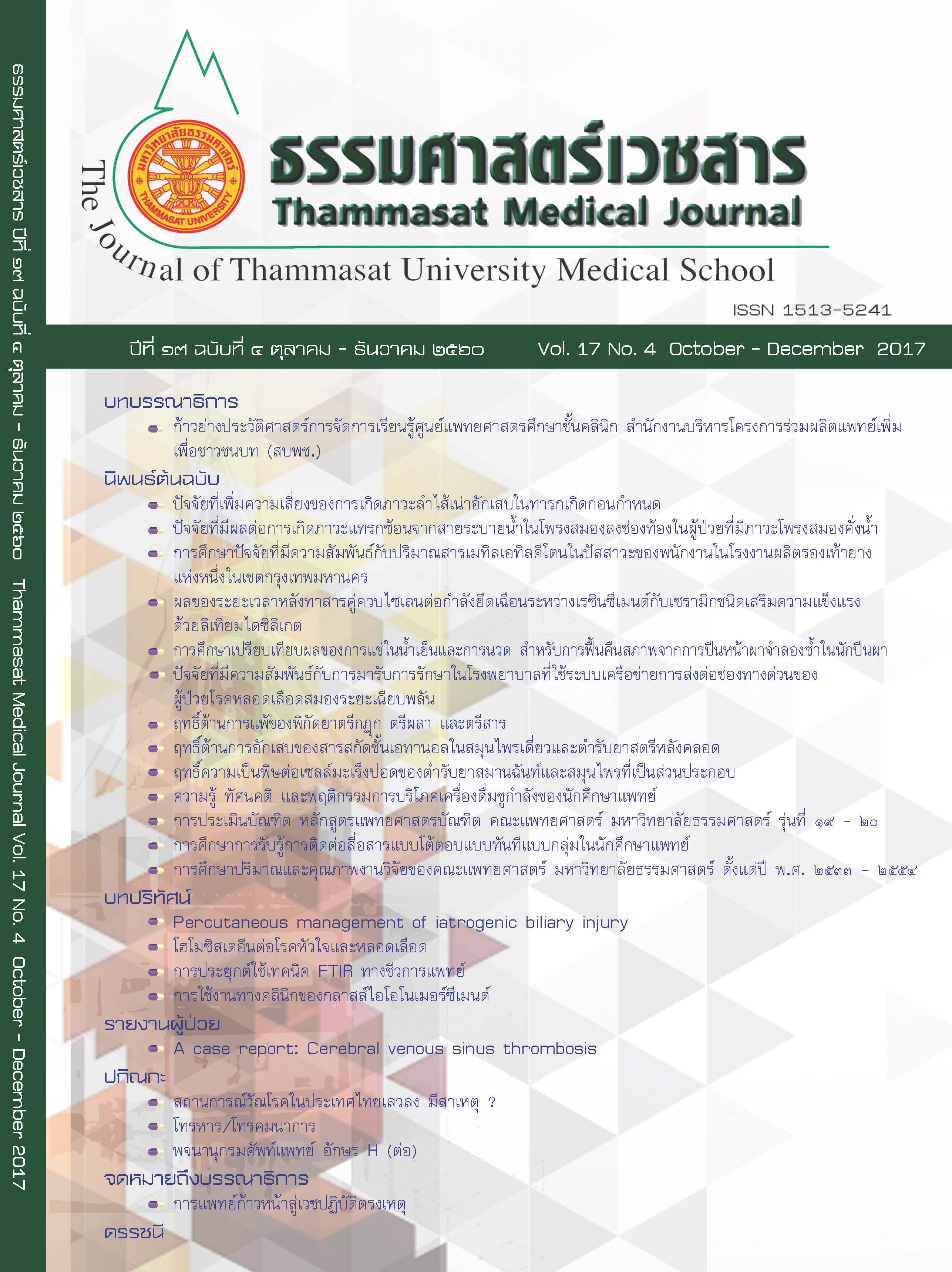Risk factors of necrotizing enterocolitis in preterm infants
Keywords:
Necrotizing enterocolitis, Preterm infants, ภาวะลำไส้เน่าอักเสบ, ทารกเกิดก่อนกำหนดAbstract
Abstract
Introduction: Advances in the treatment of preterm infants have not decreased the incidence, morbidity and mortality of necrotizing enterocolitis (NEC). The causes of NEC in preterm infants are multi-factorial. Objectives was to identify risk factors associated with NEC in preterm infants less than 34 weeks’ gestation.
Method: A retrospective review was conducted. Infants who were born at less than 34 weeks’ gestation and admitted to Neonatal Intensive Care Unit at Thammasat Hospital between July 1, 2011 and June 30, 2013 were enrolled in this study. A diagnosis of NEC was made based on clinical and radiological evidence of NEC stage II or III, according to Bell’s criteria. Multivariate logistic regression analysis was performed to identify risk factors.
Result: Twenty-two of 146 (15%) preterm infants were diagnosed as NEC. Six (27.3%) infants had positive blood cultures at the diagnosis with coagulase-negative staphylococci (83.3%) and Escherichia coli (16.7%). The risk factors associated with NEC were no prenatal care (adjusted odds ratio [OR] 6.88, 95% CI 1.27 -37.22, p = 0.03), maternal chorioamnionitis (OR 18.04, 95%CI 1.24 - 260.47, p=0.03), outborns (OR 9.93, 95% CI 1.55 - 63.73, p = 0.02) and gestational age less than 28 weeks (OR 23.74, 95%CI 4.72 - 119.42, p < 0.01).
Discussion and Conclusions: At Thammasat hospital, the incidence of NEC in preterm infants was 15%. Major risk factors of NEC were infants whose mothers had no prenatal care, maternal chorioamnionitis, infants who were born at less than 28 weeks’ gestation and transferred from other hospitals.
บทคัดย่อ
บทนำ: ถึงแม้จะมีความก้าวหน้าในการดูแลรักษาทารกเกิดก่อนกำหนด แต่อุบัติการณ์การเกิดโรค ความทุพพลภาพ และอัตราการตายของภาวะลำไส้เน่าอักเสบ (necrotizing enterocolitis, NEC) กลับไม่ลดลง ภาวะลำไส้เน่าอักเสบในทารกเกิดก่อนกำหนดเกิดจากหลายสาเหตุร่วมกัน วัตถุประสงค์เพื่อศึกษาหาปัจจัยเสี่ยงในการเกิดภาวะลำไส้เน่าอักเสบในทารกเกิดก่อนกำหนด
วิธีการศึกษา: เป็นการศึกษาแบบย้อนหลัง ทารกเกิดก่อนกำหนดทุกคนที่มีอายุครรภ์น้อยกว่า ๓๔ สัปดาห์ที่รับไว้รักษาในโรงพยาบาลธรรมศาสตร์เฉลิมพระเกียรติ ตั้งแต่วันที่ ๑ กรกฎาคม พ.ศ. ๒๕๕๔ ถึงวันที่ ๓๐ มิถุนายน พ.ศ. ๒๕๕๖ การวินิจฉัยภาวะ NEC ทำโดยใช้อาการและภาพถ่ายรังสีที่เข้าได้กับภาวะลำไส้เน่าอักเสบระยะที่ ๒ และ ๓ ตาม Bell’s criteria และใช้สถิติ multivariate logistic regression analysis ในการหาปัจจัยเสี่ยงของการเกิดภาวะลำไส้เน่าอักเสบ
ผลการศึกษา: มีทารกเกิดก่อนกำหนดจำนวน ๒๒ คนจากทารกทั้งหมด ๑๔๖ คน คิดเป็นร้อยละ ๑๕ ได้รับการวินิจฉัยภาวะลำไส้เน่าอักเสบในกลุ่มนี้มีทารกจำนวน ๖ คน คิดเป็นร้อยละ ๒๗.๓ เมื่อได้รับการวินิจฉัยภาวะลำไส้เน่าอักเสบพบว่ามีผลเพาะเชื้อในกระแสเลือดขึ้นเชื้อแบคทีเรียโดยพบว่าเป็นเชื้อ coagulase-negative staphylococci และ Escherichia coli ร้อยละ ๘๓.๓ และร้อยละ ๑๖.๗ ตามลำดับ ปัจจัยเสี่ยงของการเกิด NEC ที่มีนัยสำคัญทางสถิติ ได้แก่ มารดาไม่ฝากครรภ์ (adjusted odds ratio [OR] ๖.๘๘, 95% confidence interval [CI] ๑.๒๗ - ๓๗.๒๒, p = ๐.๐๓) มารดาได้รับการวินิจฉัยภาวะน้ำคร่ำอักเสบ (chorioamnionitis) (OR ๑๘.๐๔, 95%CI ๑.๒๔ - ๒๖๐.๔๗, p = ๐.๐๓) ทารกเกิดที่โรงพยาบาลอื่น (OR ๙.๙๓, 95% CI ๑.๕๕ - ๖๓.๗๓, p = ๐.๐๒) และทารกมีอายุครรภ์ < ๒๘ สัปดาห์ (OR ๒๓.๗๔, 95%CI ๔.๗๒ - ๑๑๙.๔๒, p < ๐.๐๑)
วิจารณ์ และสรุปผลการศึกษา: โรงพยาบาลธรรมศาสตร์เฉลิมพระเกียรติมีอุบัติการณ์การเกิด NEC ของทารกเกิดก่อนกำหนดที่มีอายุครรภ์น้อยกว่า ๓๔ สัปดาห์ คิดเป็นร้อยละ ๑๕ โดยมีปัจจัยเสี่ยงของการเกิด NEC ที่มีนัยสำคัญทางสถิติ ได้แก่ มารดาไม่ฝากครรภ์ มารดาได้รับการวินิจฉัยภาวะน้ำคร่ำอักเสบ ทารกมีอายุครรภ์ < ๒๘ สัปดาห์ และทารกเกิดที่โรงพยาบาลอื่น



